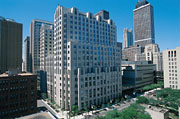
NMH was formed through the merger of Chicago Wesley Memorial and Passavant Memorial Hospital in 1972. Located in the heart of downtown Chicago, NMH provides inpatient and outpatient care to people from around Chicago and around the world. The need for a new medical center became evident in the 1980s.
A team of architects and consultants designed a 2.2-million-sq-ft facility that now includes the 17-story Feinberg Inpatient Pavilion and the 22-story Galter Outpatient Pavilion. The pavilions are connected by an eight-story base, which houses diagnostic and therapeutic services. Four hundred acute patient beds, 96 intensive care beds, 32 operating rooms, and office and clinical space for more than 1,600 physicians are housed in the $580 million facility.
A Single Point of Control
In addition to its goal of cutting operating costs, NMH wanted to successfully integrate all of its systems so that there would be a single point of control. It also wanted to provide a comfortable environment for patients, attract and retain top medical professionals, increase staff productivity, and improve overall operations while making sure the facility could meet the strict fire codes and building requirements of its downtown Chicago setting.
Bud Vance, NMH's director of facilities, considered all of these goals as he examined facility management systems. Vance was impressed by Johnson Controls' Metasys(r) BAS, which had a single-seat user interface to give the staff a central point of control for all systems. In addition to requiring fewer operating staff and less training, the technology was fully customizable.
"Patients First"
Putting patients first means guaranteeing their comfort, and temperature regulation was a key concern for NMH. Johnson Controls took into account the different temperature needs of patient rooms, intensive care rooms, laboratories and surgery suites, and designed a solution that would allow staff members to adjust the temperatures in each at the touch of a button."The technology that Johnson Controls put in place has dramatically improved our troubleshooting process," said Vance. "Our staff is now able to find and fix problems quickly, and as a result, we are able to provide the comfortable care we have promised our patients while making sure that the specific environmental needs of the medical staff are not compromised."
Safety was another concern. The city of Chicago has some of the strictest fire codes in the country. Johnson Controls investigated various systems and made recommendations on which system would work best and ensured that all systems exceeded code requirements. It then integrated the fire alarm system into its Metasys system so potential problems could be detected, monitored, and addressed from the control center.
Within NMH, the fire alarm systems, chillers, boilers, electrical systems, and other equipment is connected to the Metasys system, giving Vance and his staff unparalleled control over the entire infrastructure.
Lower Energy Costs
Equipment or system failure for NMH can mean the difference between life and death. Johnson Controls has helped NMH improve its maintenance strategies by developing better ways of doing predictive and preventive maintenance. Because the systems are now so seamlessly integrated, the maintenance staff knows more about any problems and can better address them. They can also find and fix problems before they start, minimizing downtime."This hospital never shuts down, and NMH simply cannot afford to have any downtime due to a system or equipment malfunction," explained Vance. "With the help of Johnson Controls, we have developed efficient maintenance schedules to keep our systems running smoothly."
Forecasting energy costs for NMH is difficult, but Johnson Controls has helped NMH to do some energy trending. NMH now has a better picture of how much energy is being used at different times and the costs associated with that use, which has led to both more accurate budgeting and implementation of more energy-saving measures.ES
